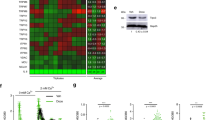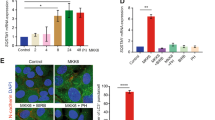Abstract
The p16INK4a cyclin-dependent kinase inhibitor has a key role in establishing stable G1 cell-cycle arrest through activating the retinoblastoma (Rb) tumour suppressor protein pRb1,2,3,4,5 in cellular senescence. Here, we show that the p16INK4a /Rb-pathway also cooperates with mitogenic signals to induce elevated intracellular levels of reactive oxygen species (ROS), thereby activating protein kinase Cδ (PKCδ) in human senescent cells. Importantly, once activated by ROS, PKCδ promotes further generation of ROS, thus establishing a positive feedback loop to sustain ROS–PKCδ signalling6,7,8. Sustained activation of ROS–PKCδ signalling irreversibly blocks cytokinesis, at least partly through reducing the level of WARTS (also known as LATS1), a mitotic exit network (MEN) kinase required for cytokinesis9,10,11, in human senescent cells. This irreversible cytokinetic block is likely to act as a second barrier to cellular immortalization ensuring stable cell-cycle arrest in human senescent cells. These results uncover an unexpected role for the p16INK4a–Rb pathway and provide a new insight into how senescent cell-cycle arrest is enforced in human cells.
This is a preview of subscription content, access via your institution
Access options
Subscribe to this journal
Receive 12 print issues and online access
$209.00 per year
only $17.42 per issue
Buy this article
- Purchase on Springer Link
- Instant access to full article PDF
Prices may be subject to local taxes which are calculated during checkout





Similar content being viewed by others
References
Lowe, S. W., Cepero, E. & Evan, G. Intrinsic tumour suppression. Nature 432, 307–315 (2004).
Sharpless, N. E. & DePinho, R. A. Cancer: crime and punishment. Nature 436, 636–637 (2005).
Serrano, M. & Blasco, M. A. Putting the stress on senescence. Curr. Opin. Cell Biol. 13, 748–753 (2001).
Drayton, S. & Peters, G. Immortalisation and transformation revisited. Curr. Opin. Genet. Dev. 12, 98–104 (2002).
Herbig, U. & Sedivy, J. M. Regulation of growth arrest in senescence: telomere damage is not the end of the story. Mech. Ageing & Dev. 127, 16–24 (2006).
Ghayur, T. et al. Proteolytic activation of protein kinase C δ by an ICE/CED 3-like protease induces characteristics of apoptosis. J. Exp. Med. 184, 2399–2404 (1996).
Bey, E. A. et al. Protein kinase Cδ is required for p47phox phosphorylation and translocation in activated human monocytes. J. Immunol. 173, 5730–5738 (2004).
Talior, I., Tennenbaum, T., Kuroki, T. & Eldar-Finkelman, H. PKC-δ-dependent activation of oxidative stress in adipocytes of obese and insulin-resistant mice: role for NADPH oxidase. Am. J. Physiol. Endocrinol. Metab. 288, E405–E411 (2005).
Iida, S. et al. Tumor suppressor WARTS ensures genomic integrity by regulating both mitotic progression and G1 tetraploidy checkpoint function. Oncogene 23, 5266–5274 (2004).
Yang, X. et al. LATS1 tumour suppressor affects cytokinesis by inhibiting LIMK1. Nature Cell Biol. 6, 609–617 (2004).
Bothos, J., Tuttle, R. L., Ottey, M., Luca, F. C. & Halazonetis, T. D. Human LATS1 is a mitotic exit network kinase. Cancer Res. 65, 6568–6575 (2005).
Sage, J., Miller, A. L., Perez-Mancera, P. A., Wysocki, J. M. & Jacks, T. Acute mutation of retinoblastoma gene function is sufficient for cell cycle re-entry. Nature 424, 223–228 (2003).
Dirac, A. M. & Bernards, R. Reversal of senescence in mouse fibroblasts through lentiviral suppression of p53. J. Biol. Chem. 278, 11731–11734 (2003).
Beausejour, C. M. et al. Reversal of human cellular senescence: roles of the p53 and p16 pathways. EMBO J. 22, 4212–4222 (2003).
Dai, C. Y. & Enders, G. H. p16INK4a can initiate an autonomous senescence program. Oncogene 19, 1613–1622 (2000).
Gorman, S. D. & Cristofalo, V. J. Reinitiation of cellular DNA synthesis in BrdU-selected nondividing senescent WI-38 cells by simian virus 40 infection. J. Cell. Physiol. 125, 122–126 (1985).
Tahara, H., Sato, E., Noda, A. & Ide, T. Increase in expression level of p21sdi1/cip1/waf1 with increasing division age in both normal and SV40-transformed human fibroblasts. Oncogene 10, 835–840 (1995).
Lloyd, A. C. Limits to lifespan. Nature Cell Biol. 4, E25–E27 (2002).
Satyanarayana, A. et al. Mitogen stimulation cooperates with telomere shortening to activate DNA damage responses and senescence signaling. Mol. Cell. Biol. 24, 5459–5474 (2004).
Irani, K. et al. Mitogenic signaling mediated by oxidants in Ras-transformed fibroblasts. Science, 275, 1649–1652 (1997).
Lee, A. C. et al. Ras proteins induce senescence by altering the intracellular levels of reactive oxygen species. J. Biol. Chem. 274, 7936–7940 (1999).
Wheaton, K. & Riabowol, K. Protein kinase C δ blocks immediate-early gene expression in senescent cells by inactivating serum response factor. Mol. Cell. Biol. 24, 7298–7311 (2004).
Konishi, H. et al. Activation of protein kinase C by tyrosine phosphorylation in response to H2O2 . Proc. Natl Acad. Sci. USA 94, 11233–11237 (1997).
Watanabe, T. et al. Cell division arrest induced by phorbol ester in CHO cells overexpressing protein kinase C-δ subspecies. Proc. Natl Acad. Sci. USA 89, 10159–10163 (1992).
Miyamoto, A. et al. Increased proliferation of B cells and auto-immunity in mice lacking protein kinase Cδ. Nature 416, 865–869 (2002).
Voorhoeve, P. M. & Agami, R. The tumor-suppressive functions of the human INK4A locus. Cancer Cell 4, 311–319 (2003).
Serrano, M., Lin, A. W., McCurrach, M. E., Beach, D. & Lowe, S. W. Oncogenic ras provokes premature cell senescence associated with accumulation of p53 and p16INK4a. Cell 88, 593–602 (1997).
Ohtani, N. et al. Opposing effects of Ets and Id proteins on p16INK4a expression during cellular senescence. Nature 409, 1067–1070 (2001).
Maehara, K. et al. Reduction of total E2F/DP activity induces senescence-like cell cycle arrest in cancer cells lacking functional pRB and p53. J. Cell Biol. 168, 553–560 (2005).
Behrend, L., Mohr, A., Dick, T. & Zwacka, R. M. Manganase superoxide dismutase induces p53-dependent senescence in colorectal cancer cells. Mol. Cell. Biol. 25, 7758–7769 (2005).
Chen, J. H. et al. Loss of proliferative capacity and induction of senescence in oxidative stressed human fibroblasts. J. Biol. Chem. 279, 49439–49446 (2004).
Acknowledgements
We thank D. Mann, G. Peters, J. Campisi and U. Kikkawa for helpful comments on the manuscript; R. Agami for providing p16 knockdown construct; D. Beach and G. Hannon for providing pMarX retrovirus vector; W. Jiang and R. Fukunaga for providing anti-PRC1 antibody; and D. Kufe and S. Ohno for PKCδ cDNA. We also thank A. Hirao for his useful suggestion in analysis of intracellular ROS. This work was supported by grants from Ministry of Education, Science, Sports and Technology of Japan, Ministry of Health, Labour and Welfare of Japan, the Uehara Memorial Foundation, the Sumitomo Foundation, the Nakatomi Foundation, the Sagawa Foundation for Promotion of Cancer Research, the Inamori Foundation and Sankyo Foundation of Life Science (E.H.). A.T. is supported by the Japan Society for the Promotion of Science.
Author information
Authors and Affiliations
Corresponding author
Ethics declarations
Competing interests
The authors declare no competing financial interests.
Supplementary information
Supplementary Information
Supplementary Figures S1, S2 and S3 (PDF 490 kb)
Rights and permissions
About this article
Cite this article
Takahashi, A., Ohtani, N., Yamakoshi, K. et al. Mitogenic signalling and the p16INK4a–Rb pathway cooperate to enforce irreversible cellular senescence. Nat Cell Biol 8, 1291–1297 (2006). https://doi.org/10.1038/ncb1491
Received:
Accepted:
Published:
Issue Date:
DOI: https://doi.org/10.1038/ncb1491
This article is cited by
-
Long-term exposure to polystyrene microplastics triggers premature testicular aging
Particle and Fibre Toxicology (2023)
-
The roles and mechanisms of senescence-associated secretory phenotype (SASP): can it be controlled by senolysis?
Inflammation and Regeneration (2022)
-
RNaseH2A downregulation drives inflammatory gene expression via genomic DNA fragmentation in senescent and cancer cells
Communications Biology (2022)
-
Senescence and cancer — role and therapeutic opportunities
Nature Reviews Clinical Oncology (2022)
-
Epimedium protects against dyszoospermia in mice with Pex3 knockout by exerting antioxidant effects and regulating the expression level of P16
Cell Death & Disease (2022)



